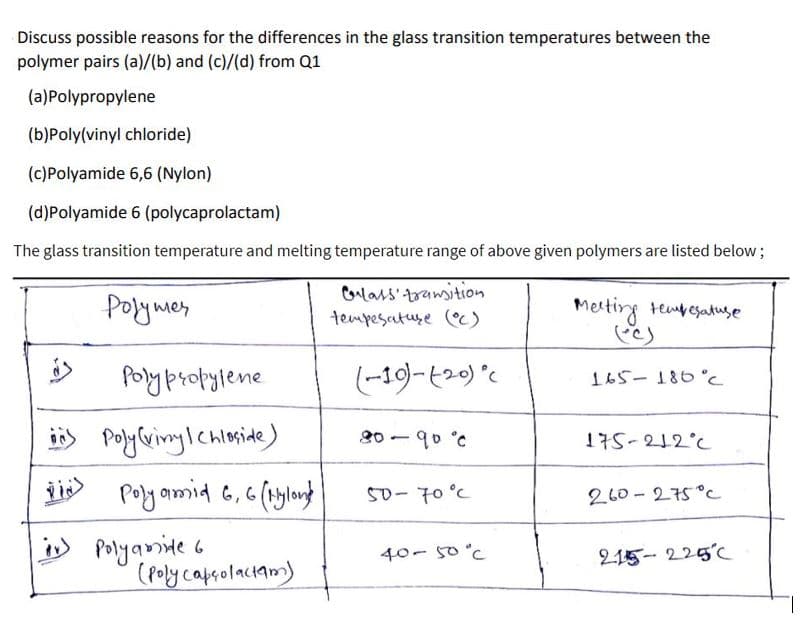Discuss possible reasons for the differences in the glass transition temperatures between the polymer pairs (a)/(b) and (c)/(d) from Q1 (a)Polypropylene (b)Poly(vinyl chloride) (c)Polyamide 6,6 (Nylon) (d)Polyamide 6 (polycaprolactam) The glass transition temperature and melting temperature range of above given polymers are listed below; Polymey Olars'transition tempesatuse () Merting teupesatuse (-19)-t20) *c 165- 186 c i) Polylvinylchloside) 20 -90°c 175-212°C polyamid 6, 6 (1ylon 50- 70 °C 260 - 275°C » Polyamite 6 (Polycapeolactam) 40- 50 C 215- 225'C
Discuss possible reasons for the differences in the glass transition temperatures between the polymer pairs (a)/(b) and (c)/(d) from Q1 (a)Polypropylene (b)Poly(vinyl chloride) (c)Polyamide 6,6 (Nylon) (d)Polyamide 6 (polycaprolactam) The glass transition temperature and melting temperature range of above given polymers are listed below; Polymey Olars'transition tempesatuse () Merting teupesatuse (-19)-t20) *c 165- 186 c i) Polylvinylchloside) 20 -90°c 175-212°C polyamid 6, 6 (1ylon 50- 70 °C 260 - 275°C » Polyamite 6 (Polycapeolactam) 40- 50 C 215- 225'C
Introduction to Chemical Engineering Thermodynamics
8th Edition
ISBN:9781259696527
Author:J.M. Smith Termodinamica en ingenieria quimica, Hendrick C Van Ness, Michael Abbott, Mark Swihart
Publisher:J.M. Smith Termodinamica en ingenieria quimica, Hendrick C Van Ness, Michael Abbott, Mark Swihart
Chapter1: Introduction
Section: Chapter Questions
Problem 1.1P
Related questions
Question

Transcribed Image Text:Discuss possible reasons for the differences in the glass transition temperatures between the
polymer pairs (a)/(b) and (c)/(d) from Q1
(a)Polypropylene
(b)Poly(vinyl chloride)
(c)Polyamide 6,6 (Nylon)
(d)Polyamide 6 (polycaprolactam)
The glass transition temperature and melting temperature range of above given polymers are listed below;
Polymes
Olars transition
tempesature (c)
Meiting tempesatuse
Porypropylene
(--19)-t20) °c
165- 186 °c
i) Polyvinylchleside)
ji Poly amid 6, 6 (1ylongd
20 - 90 °c
175-212°C
50-70 °C
260 -275°C
i) Polyqmnite 6
(Polycapsolaciam)
40- 50'c
215- 225'C
Expert Solution
This question has been solved!
Explore an expertly crafted, step-by-step solution for a thorough understanding of key concepts.
This is a popular solution!
Trending now
This is a popular solution!
Step by step
Solved in 3 steps

Recommended textbooks for you

Introduction to Chemical Engineering Thermodynami…
Chemical Engineering
ISBN:
9781259696527
Author:
J.M. Smith Termodinamica en ingenieria quimica, Hendrick C Van Ness, Michael Abbott, Mark Swihart
Publisher:
McGraw-Hill Education

Elementary Principles of Chemical Processes, Bind…
Chemical Engineering
ISBN:
9781118431221
Author:
Richard M. Felder, Ronald W. Rousseau, Lisa G. Bullard
Publisher:
WILEY

Elements of Chemical Reaction Engineering (5th Ed…
Chemical Engineering
ISBN:
9780133887518
Author:
H. Scott Fogler
Publisher:
Prentice Hall

Introduction to Chemical Engineering Thermodynami…
Chemical Engineering
ISBN:
9781259696527
Author:
J.M. Smith Termodinamica en ingenieria quimica, Hendrick C Van Ness, Michael Abbott, Mark Swihart
Publisher:
McGraw-Hill Education

Elementary Principles of Chemical Processes, Bind…
Chemical Engineering
ISBN:
9781118431221
Author:
Richard M. Felder, Ronald W. Rousseau, Lisa G. Bullard
Publisher:
WILEY

Elements of Chemical Reaction Engineering (5th Ed…
Chemical Engineering
ISBN:
9780133887518
Author:
H. Scott Fogler
Publisher:
Prentice Hall


Industrial Plastics: Theory and Applications
Chemical Engineering
ISBN:
9781285061238
Author:
Lokensgard, Erik
Publisher:
Delmar Cengage Learning

Unit Operations of Chemical Engineering
Chemical Engineering
ISBN:
9780072848236
Author:
Warren McCabe, Julian C. Smith, Peter Harriott
Publisher:
McGraw-Hill Companies, The